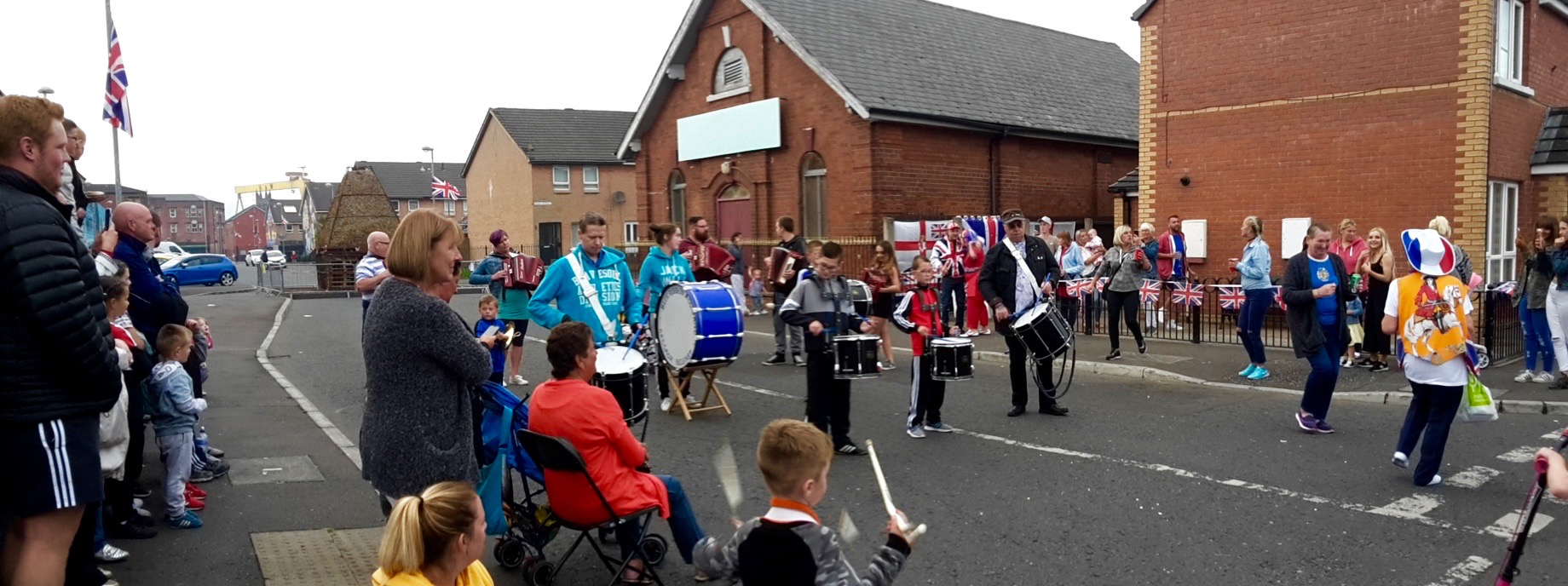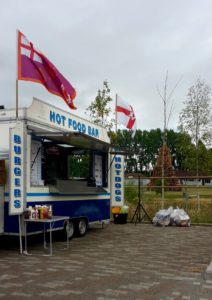The Twelfth of July is a time of sparks and short fuses here. It’s the day when loyalist Northern Ireland commemorates the Battle of the Boyne, where the Protestant Dutch king William III defeated the Catholic James II on the 12th of July 1690, vanquishing the Irish for the British crown and ramping up the Protestant Ascendancy in Ireland. King Billy had been invited to the English crown by Protestant opponents of James. He came, with 40,000 men and the blessing of the Pope who didn’t like James’ ally, king Louis XIV of France. He sailed across the North Sea with a huge fleet in 1688, and pursued James when the latter retreated to Ireland.
The great bonfires lit on the night of the Eleventh of July mimic the fires lit to pilot Billy’s 300 ships into Belfast Lough in 1690. ‘Séamus An Chaca’ (James the Shit) didn’t put up much of a fight and deserted his Irish soldiers in an escape to France, delivering Ireland to easy conquest by Billy at the River Boyne.
Though a strategic turning point, the Battle of the Boyne was only one battle during the European wars of religion that rocked the continent for nearly two hundred years, involving everyone from Rome and Italy to Germany to the Netherlands-Belgium, Denmark-Norway, Switzerland, Spain, France, Scotland and England. Ireland, not for the last time, functioned as Europe’s doormat, which the titan superpowers of England and France chose as the location for one of their epic showdowns. While the titans soon went on to other things to bicker over, the doormat was to feel the pain of this Glorious Quarrel throughout the centuries to come.
The commemoration of the Twelfth began one hundred years after the Battle, when the Orange Order was founded in 1795. Seen in its historical context, the Order centred on the glorification of a monarch at a time when republican revolutions were shaking Europe (the French Revolution of 1789 had just profoundly altered the course of European history, triggering the Irish Revolution in 1798). But this monarch stands for more than loyalty to a crown. The Eleventh with its bonfires burning tricolor flags and nationalist/Catholic effigies, and the Twelfth with its marching band parading through Catholic communities are the annual peak of tension in Northern Ireland. It’s an expression of cultural identity and historical legacy to loyalists, and a sectarian and supremacist provocation to many Catholics and nationalists.
The year’s biggest party for some, time to board up or flee the country for others, and in all its controversy it has traditionally marked the start of the rioting season. This year: a hijacked bus petrol bombed in Newtownards by paramilitaries in balaclavas, a pipe bomb tossed over the wall of the Short Strand Catholic estate in East Belfast (a flashpoint on the Twelfth), a hoax bomb in a car and dozens and dozens of petrol bombs in Derry/Londonderry, and some rioting and roadblocks in North and East Belfast following the unannounced removal of a number of bonfires by council police.
It is too easy, too lazy to unquestioningly fall in line with what I’ve heard people say about the Twelfth. I can’t pretend to feel any of the native emotional baggage, but I feel weirdly complicit as a native from the country of King Billy. So I went, with an American fellow volunteer, to see for myself his plentiful image resplendent on banners, flags and jackets in a foreign city. Crowds of foreigners donned in the colour of my country’s royal house for a day.
We filled the Eleventh with three separate tours of Belfast. A republican taxi driver introduced us to the Shankill and Falls Roads, the back to back loyalist and republican nerve centres of the city, separated by 8-metre high ‘peace walls’ where tourists infuriatingly throw their opinions into the mix with graffiti messages like ‘Love is all you need’ and ‘It’s time to tear these walls down’ and ‘Trump is a fascist’. He tried his very best to stay neutral on these two most aggravating days. Then a loyalist friend drove us through streets and streets of Union, Scottish, English, Ulster, Orange Order and paramilitary flags to see the biggest pallet ‘bonnies’ ready to be lit that night. He took us to a neighbourhood street party somewhere in East Belfast where his marching band was to play a couple of tunes. Grandmas with red-white-and-blue mohawks and lots of excited kids. A raffle for a monkey painting painted by John from next-door and free hamburgers.
Apart from our self-consciousness as blatant outsiders trying to lie low, it was the anthropologist’s dream to be privy to that scene. It was fun, people sang along to all the tunes and happily clad themselves in the union flag they feel at home with. We also saw the tricolor flags of the Republic of Ireland strapped to their funeral pyre. There’s orange in that flag, of all colours, and every year the steps towards peace between green and orange are ceremonially burned to the ground. You’ve got to want to change. After sunset we drove around the hills surrounding Belfast with our host, chasing a good view of the city on fire. The dark hillside roads were bustling with people with that same idea; classic middle class folks, disapprovingly watching the world burn from a safe distance.
On the telly the next morning there’s lines after lines of chirping flutes, military uniforms and bowler hats, and lads whacking furiously on heavy bass drums. Big bellied men sporting strong moustaches and orange sashes reading LOL (oh irony in the age of memes) are introduced with intimidating long titles along the lines of Sovereign Grand Master of the Imperial Grand Black Chapter. Grand titles and brethren, oaths and authority of Christian scripture, and favourite words like ‘defending’, ‘protecting’, ‘freedom’ and ‘tradition’ are curiously reminiscent of another religious order with pointy hats, marked opinions and a dubious past across the big pond, as far as my immediate associations go.
In the late morning I go to see them in real life. Army culture and war glorification… ain’t nothing new around here. They’ve fought over stranger things. Once upon a time all of Connaught went to war against all of Ulster over a brown bull in the Cattle Raid of Cooley. It’s a story so approved of, apparently, that they’ve been telling it here for centuries.
To the oblivious tourist, it felt like your average big tacky public holiday, like the American 4th of July or King’s Day in my country. To cultural insiders, caught up and complicit in the story, it is a triggering and polemic public holiday, like the American Thanksgiving or my Dutch Sinterklaas. In all three cases, the simplest thing is for the celebrants to acknowledge their party’s problematic history and modify the tradition somewhat. Change a few colours, leave out some pope effigies, red Indians and Blackface ‘helpers’. Say sorry, adjust and get on with it, and no need for the non-party-people to condemn the party-people’s entire culture, identity and humanity around it.
If only. But there’s always a delay in a nation’s adjustment to evolving history and hindsight, because the story is carried by so many and crowd hysteria is a potent and contagious thing. A delay of a couple decades, a couple centuries, sometimes not enough to settle in before the next outburst of violence. History is a mad merry-go-round.
Of course, to ease the confused conscience, my visit to the city ended in a truly cliché peacebuildery way. Traversing the city with my head full of contradictions and unprocessed impressions, I get a tap on my elbow. I turn around to a smiling face. “I met you at Corrymeela a few weeks ago!” The woman helps my memory and I remember. Her name is Aileen and she was up at the centre with a group of cancer patients and their carers – which one she was I never found out – and we shared some lovely moments of looking at leaves and eating rhubarb crumble. Today, she is sporting an orange umbrella and a cowboy hat screaming with a hundred glittery union jacks. Here we are, a Dutch woman whose king made a mess, and a woman loyal to the British crown in whose name he made the mess, embracing above the Irish soil the mess seeped into, in the shade of a glittery union jack three hundred years later. Embracing not because we relate to each other’s ideologies, but because human lives are relatable.
Much there is to learn about our own countries and their involvement abroad over the course of centuries. It’s been a globalised world for a while, and the borders we draw and re-draw are unhelpful obstructions to our view of it. How poignant the influence of geography on social issues: ‘peace walls’ protecting communities on both sides from confrontation with the other and confrontation with the self; the middle class frowning down on the plebeian rumpus from the moral high ground of the surrounding hills; the annual exodus of nationalist families who’ve all fled to Donegal for the week, blocking out the very existence of these days’ events; and the contrast of the city’s brouhaha and the removed calm of the coast. That’s where I’m back now after this cultural outing, with enough to mull over while I recline on my spacious hill on the scenic North Antrim coast.
Reported by your Dutch white millennial leftie middle class correspondent. Over and out.



